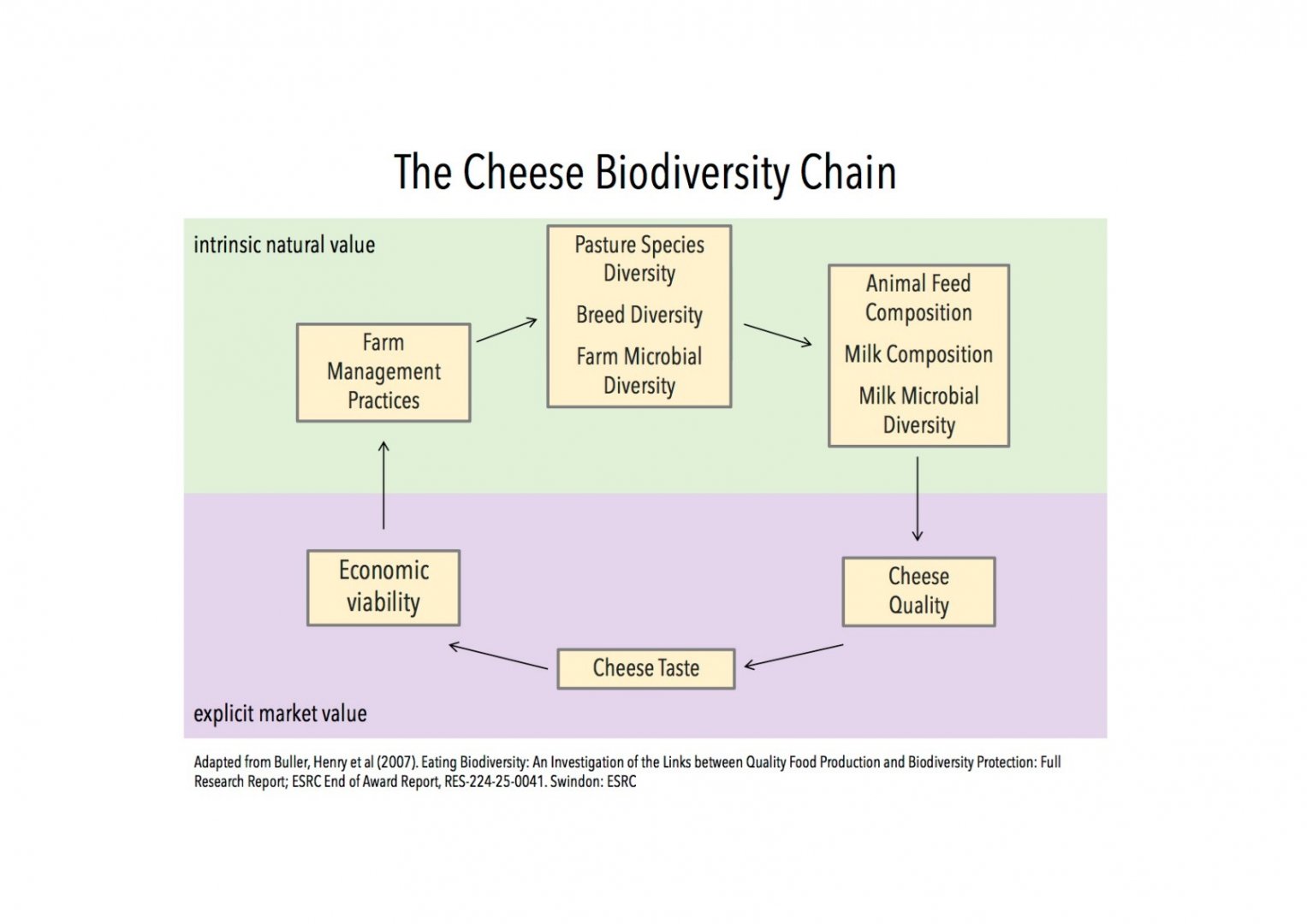
The theme of the BCBC’s 2019 conference – Building the Brand to Promote our Uniqueness – is an explicit acknowledgement that commodity farming on a small-tomedium scale is a dead end for primary producers. Increasing numbers of farmers under financial pressure have turned to processing their milk on the farm, producing value-added products such as cheese in order to insulate themselves from the vagaries of the liquid milk market and save their family businesses.(1)
In contrast to liquid milk – and even to dairy products such as yoghurt or ice cream – cheese, and particularly raw-milk cheese, presents consumers with the opportunity to taste the farming decisions that go into its production. Liquid milk tastes more or less ‘milky’ and sweet, and the flavours of yoghurts and dairy desserts are dominated by a primary lactic acidification or added sugar and flavourings. The flavour of cheese, on the other hand, represents the cumulative impact of multiple factors at the level of primary production.
Farming on Three Levels
Cheesemaking is farming on three distinct scales. At the macro scale, we have the pastures of the farm and the soil and climatic conditions that support the growth of its distinctive community of plants. The decisions by the farmer at this level have a profound impact on the chemical and compositional characteristics of the milk, and thus the cheese that can be made with it. Are animals kept on permanent grassland? What crops are grown and what does the rotation look like? Is the system organic? Are animals fed for consistency and insulated as much as possible from the vagaries and inherent quirks of the climate and the site?
Then we move to the meso level of cheesefarming: breed. Decisions about breed, and subsequent decisions about the most favourable characteristics to pursue, are inextricably linked to the macro-level decisions mentioned above. Putting a heritage cow like a Northern Dairy Shorthorn or Irish Moiled into a modern production system would be an economic catastrophe; conversely, a modern Holstein would wither within a conservation grazing setup.
Breeds such as the Montbéliarde are touted as having been bred to give milk with exceptional cheesemaking qualities, such as a high protein-to-fat ratio and low somatic cell count. (2) However, the primary consideration when selecting a breed for cheese is its suitability for a given farming system. Over the course of a multiyear experiment carried out in the Auvergne the Montbéliarde cows, widely celebrated for their adaptation to grazing-based systems, struggled to maintain fertility with a completely grass-based diet, while the local Salers cows do not experience similar issues.(3) Within extensive and high-value-added systems, hardiness and ability to get to the interesting food are paramount.
Finally, at the micro scale, cheesemaking is farming microbes. While most modern cheese operations add commercial cultures to their milk to facilitate a quick and efficient fermentation, carefully-produced raw milk comes loaded with its own population of acidifying and ripening bacteria, yeasts, and moulds. The role of the cheesemaker is then to process the milk in such a way that the interesting and beneficial microbes grow to dominate the finished cheese. The enzymes released by these microbes during the ripening process give rise to each cheese’s unique flavour and aroma.
As with the feeding and breeding decisions, each farm has the potential to host a unique population of diverse microbes, which have evolved in response to the climate and the environments created for them by the herdsperson and the cheesemaker throughout the farm and cheese dairy. Think of this as creating a system selectively to breed microbes. This unique microbial fingerprint, again, is something that can be tasted in the flavours of the finished cheese. Cheese is milk made knowable, and rather than ‘adding’ value, the best cheesemaking reveals the inherent character and value of the milk itself.
Tasting a farming system
The decisions made by the farmer are writ large in the flavour and texture of the resulting cheese. We see this most clearly when we look at cheeses made from the milk of animals fed entirely on grass-based forage versus those fed a diet rich in maize and/or concentrates. Grass, unlike maize, is rich in beta-carotene, a fat-soluble pigment that gives cow’s milk its golden colour. The higher in grass the diet, the richer the colour of the cheese. (Because beta-carotene is broken down by UV light, silage, which may be wilted in the field for several days before it is moved to the clamp or baled, produces cheese with a slightly lighter colour; this is even more the case for hay.) Conversely, maize silage and concentrates such as brewers’ grains or soya have no beta-carotene, and thus the milk produced in systems that rely heavily on them are lighter in hue. The differences go beyond just colour; milk from cows eating a diet of primarily grass has a higher ratio of unsaturated fatty acids, which results in fats that are softer at room temperature. All else being equal, grass-fed cheeses are softer and more pliant.(4)
Field-level biodiversity can also be tasted in the resulting cheeses. Milk from animals that graze on biodiverse swards contains higher levels of terpenes, aromatic molecules that are the main component of essential oils. While these compounds cannotbe detected by tasters in the milk or cheese, they do alter the ripening profile of cheeses in such a way that sensory panels can differentiate between mature cheeses made from the milk of animals on highbiodiversity versus low-biodiversity grassland in blind taste trials.(5)
Against this backdrop, the role of the breed becomes clear: to enhance the link between an interesting place and the flavour and characteristics of the resulting cheese. Cows with high energy requirements will need to consume a more significant proportion of their energy as concentrates to stay in condition, which weakens the link with the farm. Breeds with lower energy requirements can thrive on marginal land with high environmental value, and managed properly, can play an important role in the conservation of these delicate and endangered environments.
Organisations such as the Mountain Cheese Network, a coalition of scientists and cheese producers’ groups, recognise the systemic nature of this challenge, seeking ‘an optimal management of the complex and interconnected ecosystems of the chain from field to animal, farm, milk, and cheese . . . because each link greatly determines the final qualities of the cheeses.’(6) Some of the world’s most iconic cheeses are made within austere, extensive systems, from the milk of the animals that thrive in them, from the rugged Salers of the Auvergne, to Swiss Etivaz, the products of thrifty breeds that stay healthy and fertile on biodiverse, scrubby pasture.
What British equivalents could be revived or created from the milk of cattle grazed entirely on Devonian moorland, in the upland hay meadows of the Yorkshire dales, or in lowland heath and wetlands? In addition to giving rise to thrilling new cheeses, these dual-purpose animals would have excellent carcass value, as well as play a valuable role in the conservation of these endangered habitats.
The cheese biodiversity chain
Here we present a model, the Cheese Biodiversity Chain, adapted from the work of Dr Henry Buller at the University of Exeter.(7) Buller’s work serves to underline the importance of taste in the economic viability of extensive farming systems, which he and others have demonstrated previously in the context of the market for pasture-raised speciality meats. The model links the aspects of the system that carry intrinsic natural value – the biodiversity of the farm landscape, the genetic diversity of animals and microbes – with the extrinsic attributes of the goods produced within that system, in this case delicious and unique cheeses that sustain a price significantly higher than their counterparts produced within an intensive system at an industrial scale. (See Figure 1). Moreover, by locating the processing at the level of the farm, the value of the cheese is realised by the farmer. This higher level of profitability not only makes way for a secure business, but promotes further investment in the farm and its health.
Figure 1 The Cheese Biodiversity Chain

Why is this not the dominant commercial structure in the rural economy? Many small-scale cheesemakers, particularly within the UK, take their aesthetic cues from factory templates. Factory cheeses are made using commercial strains of microbes selected for their ability to produce consistent flavours, from the caramel sweetness of aged Gouda to the industrial microbial monoculture of the rind of Somerset Brie. These characteristics are added during the cheesemaking process, breaking the link between the farming system and the flavour of the cheese.(8) For factories looking to make the cheapest cheese possible, this is ideal; for small producers looking to create a cheese that will sustain a significantly higher price, these cultures are an existential threat. If a similar-tasting cheese can be delivered for a quarter of the price, what rational customer would choose to pay more?
Conversely, no factory can replicate the flavour of a cheese produced within an extensive, biodiverse farming system, driven by the potential of its native microbial community. These are the flavours of place, and give us as an industry the opportunity to tell a story that customers can actually taste.
References
1 McGuigan, Patrick. ‘How British cheese took over the world (even the French love it).’ The Telegraph, 30 April 2015.
2 Montbeliarde.org. (2018) Montbéliarde Association – The perfect milk for the cheese maker. [online] Available at: https://www.montbeliarde.org/en-1555.html
[Accessed 20 Dec 2018].
3 Pomies, D. et al. (2013) ‘Design of low-input dairy farming systems in mountain areas: animal performances and cheese sensory properties.’ Proceedings of the 17th Meeting of the FAO-CIHEAM Mountain Pasture Network, 22–26.
4 Pirisi, A. et al. (2004) ‘Relationships between ruminant management and sensory characteristics of cheeses: a review.’ Lait, 84: 221–241.
5 Martin, B. et al. (2005) ‘How do the nature of forages and pasture diversity influence the sensory quality of dairy livestock products?’ Animal Science, 81: 205–212.
6 Padovauniversitypress.it. (2018) 12th International Meeting on Mountain cheese. PADOVA UNIVERSITY PRESS. [online] Available at: http://www.padovauniversitypress.it/ publications/9788869380594 [Accessed 20 Dec 2018].
7 Buller, Henry et al. (2007) ‘Eating Biodiversity: An Investigation of the Links between Quality Food Production and Biodiversity Protection: Full Research Report.’ ESRC End of Award Report, RES-224-25-0041. Swindon: ESRC.
8 Bérodier, F. (1996) ‘Lien entre la flore bactérienne des laits et le goût du Comté à affinage constant.’ Internal report, Comité Technique du Comté, 25pp. 58